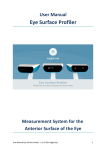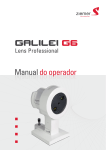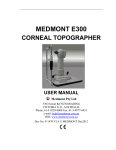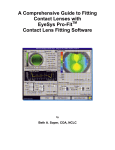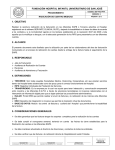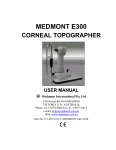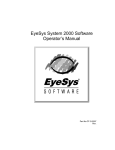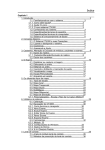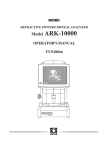Download ESP User Manual V4a DH
Transcript
How to get the best use out of me Let’s get to work! Eaglet Eye : User Manual eaglet-eye.com EMPLOYER MANUAL Measurement system for the Anterior surface of the eye eaglet-eye.com Introduction Thank you for purchasing this Eye Surface Profiler (ESP) system and for your confidence in Eaglet Eye. The ESP gives you highly precise measurements of the front surface of the eye, not only of the cornea but also a large part of the sclera. We are committed to assuring your complete satisfaction with the ESP. Eaglet Eye : User Manual At Eaglet Eye, we continue our research and development to further extend the capabilities of all our products and solutions. This may result in improvements of certain features of the ESP system that have not yet been updated in the user manual. We strive to minimize these differences and come with regular updates of the manual. For your safety it is essential that you read this manual carefully and that you familiarize yourself with its content before you start using this device. In particular, pay close attention to the safety instructions in this manual. If you have any questions or desire further information on this product, please contact us via the website or email us. Our team will be glad to help you. The Eaglet Eye team Eaglet Eye : User Manual eaglet-eye.com Description The Eye Surface Profiler (ESP) is a system using Fourier Transform Profilometry that measures the anterior surface of the cornea, the limbus and large parts of the sclera. Up to 20mm diameter of the visible anterior surface can be measured. The ESP requires fluorescein instilled in the eye so that the projected light is scattered back from the eye front surface. The measurement process consists of 3 single shots in rapid succession that last a few milliseconds. The ESP calculates a 3-dimensional model of the anterior surface of the eye with on average more than 250.000 measurement points. From these measurement points, maps and parameters are calculated automatically that assist in the evaluation of the shape of the cornea, limbus and sclera. Separately, the pupil size and iris size are determined automatically from a top view image. The ESP measures the complete anterior front surface of the eye up to 20mm without extrapolation. The corneal limbus is the border of the cornea and the sclera. The average corneal diameter is 11.77 +/- 0.37 mm for males and 11.64 +/- 0.47 mm for females. The new software will detect the limbus automatically and will give you detailed information about the whole cornea. The ESP is a Profilometry based system and has therefore no interference with the shadow of the nose. Eaglet Eye : User Manual eaglet-eye.com Contents 01. Quick Reference Guide 02. Components Important elements View window Connections 03. Safety Setting up and installation of equipment Technical details of the ESP 04. Operational instructions Home screen overview Database Location Add a patient New measurement Finding an existing patient Search results History Viewing results Parameters Sagittal height Figures Source Grid Bisphere elevation Bisphere 3D Tangent angles map Tangent angles 3D map Height 03 04 04 04 04 05 07 08 09 09 09 11 11 15 15 15 16 16 20 22 22 23 23 24 24 25 25 eaglet-eye.com Eaglet Eye : User Manual Height 3D Fluorescein simulation map Tangential curvature Axial curvature Refractive power Corneal elevation Quad map Notes Evaluating functionalities 05. Exporting, Printing and Comparing Results 06. Lens Design Module 07. Troubleshooting 08. Maintenance and service Care and maintenance Casing Optical components Software installation Minimum PC requirements Conditions of warranty Liability for malfunction and damages 09. Compliance EMC CE Index Address of manufacturer and service department 26 26 27 28 29 29 30 30 31 32 36 38 39 39 39 39 39 40 40 41 42 42 42 43 45 Eaglet Eye : User Manual eaglet-eye.com 01 03 Quick Reference Guide 02 Components eaglet-eye.com Important elements 1. Forehead support 2. Optimal eye height indicator 3. Chin rest 4. Chin rest height adjustment swivel 5. Joystick 6. Fire button 7. View window 1. 2. 7. 3. 4. 6. 5. Eaglet Eye : User Manual View window 8. Digital camera 9. Focus help LEDs 10. Fixation cross 11. Measure pattern projectors Connections 12. USB Port 13. DC power inlet 14. Power adapter 12. 13. 14. 8. 10. 9. 11. 04 eaglet-eye.com 03 Safety To assure safe operation, it is imperative that the instrument is used according to the instructions in this manual. Therefore, you should become thoroughly familiar with the content of the user manual before putting the system into operation. The Eye Surface Profiler (ESP) system must only be operated by trained personnel capable of using it properly on the basis of their training, expertise and practical experience. Eaglet Eye : User Manual Please save this user manual and ensure that it is accessible to operating personnel at all times. This instrument must only be used for purposes as laid down in this user manual. Before using this instrument for the first time, you must be instructed on how to use it by our staff or an authorized dealer. Only operate the instrument with the original components supplied by Eaglet Eye and if the instrument is in good working condition. Should the instrument be defective, do not operate it, and contact the supplier. Before maintenance and cleaning the instrument, always pull out the power plug of the ESP and all equipment attached to it, for example a printer. Do not connect cables if this proves difficult. If it is impossible to make a connection, check to see whether the plug fits into the socket. In case you ascertain a defect, contact your authorized dealer to have it repaired by our service team. When disconnecting electrical connections, always pull on the plugs, not on the cables. Supplementary equipment which is connected to the analog or digital interfaces of the instrument 05 Eaglet Eye : User Manual eaglet-eye.com must comply with relevant specifications. For detailed instruction on maintenance and cleaning turn to the chapter on Maintenance and Service in this manual. If the ESP is coupled with external electrical equipment (for ex. a printer) this must not result in a decrease of patient safety. If the coupling of equipment causes the tolerance levels for leakage current to be exceeded, safety features, which include a disconnection device, must be provided for. Do not operate the delivered equipment • in areas with risk of explosion, • in the presence of flammable anesthetics or volatile solvents such as alcohol, benzene or similar substances. Do not use or store the instrument in damp rooms. Avoid placing the instrument in the vicinity of dripping, running or spraying water and ensure that no moisture can penetrate the instrument. For this reason, do not place any containers filled with fluids near the instrument. When cleaning the instrument with a damp cloth, be sure that no moisture enters it. This instrument is a high-quality technical product containing sophisticated optics. In order to assure faultless and safe operation, service inspections must be performed according to the service plan of Eaglet Eye. See also the chapter on Maintenance and Service in this manual. Eaglet Eye emphasizes that the user bears the full responsibility for the correctness of data measured, calculated or displayed using the ESP. The manufacturer will not accept claims based on erroneous data. 06 Setting up and installation of equipment Eaglet Eye : User Manual eaglet-eye.com Before initial operation, the ESP needs to be set up and connected by an authorized dealer or service department. Before installing the ESP, please consider the transport, storage and current room temperature where the device is to be installed. Make sure the device is at room temperature. The ESP must be placed at a place prevented from direct (day)light from influencing the components. A reflection-free examination must be assured. Therefore, the ESP should be used in a darkened room. When placing the measurement head on the base plate, make sure the wheels are exactly aligned in the rail. This can be easily checked when holding a card at the base plate and at the end of the rail, the wheels should touch the card at both sides. If this is not the case, adjust the wheels in the rail. This is an optical device and should be handled with care. Do not subject it to vibrations, jolts or high temperatures. 07 Important elements Seizes (Depth*Width*Height)= 35 cm*35 cm * 48 cm Weight: 12 kg Energy and power: PLUG POWER SUPPLY, 10W, EU, 7.5V • Power Supply Output Type: Fixed • Input Voltage AC Min: 90V • Input Voltage AC Max: 264V • Output Voltage Nom.: 7.5V • Output Current Max: 1.14A • Output Power Max: 8W • Output Connector: Barrel Plug • SVHC: No SVHC (16-Jun-2014) • Applications: General Purpose • No. of Outputs: 1 • Output Current: 1.14A • Output Voltage: 7.5V • Power Rating: 8W Power consumption: 8W Eaglet Eye : User Manual eaglet-eye.com Model: ESP 20200 08 Eaglet Eye : User Manual eaglet-eye.com 04 Operational Instructions Home screen overview Database location When installing the Eye Surface Profiler software, the database for new measurements will automatically be saved on: C:\Users\COMPUTERNAME\AppData\Roaming\Eaglet Eye\Eye Surface Profiler. This can be changed to a location of preference by clicking settings - database - move database. See picture below. The location has to be a mapped drive (for example: C: / F:). This opens the possibility to open the database on different locations. 09 eaglet-eye.com In this screen (see picture below) it is also possible to select a database if the eye care professional saved several databases. Eaglet Eye : User Manual The Eye Surface Profiler software home screen consists of three columns: Column Description Customer column From this column recent customers can be selected as well as new patients that can be added New measurement column Enables access to new measurements if a patient is selected Results column Contains a list of recent measurements 10 Add a patient Before starting a measurement the patient must be entered into Eaglet-Eye Surface Profiler. To add a patient, take the steps listed below: eaglet-eye.com 1. Go to the home screen; 2. Click on the plus sign in the ‘Customer column’; ‘Customer column’ changes to four input fields for the patient data 3. Enter the required data; - Given name - Family name - Birthdate - Patient ID Eaglet Eye : User Manual 4. Click ‘Apply’. New measurement A new measurement can be made by pressing the button ‘New measurement’. This button is disabled if no customer is selected. Making a new measurement is done by following the steps listed below: 1. Make sure the patient does not wear contact lenses; 2. Select the patient from the customers (if the patient is not available enter the patient following the ‘add a patient’ procedure); The name of the patient appears in the customer column title. The button ‘New measurement’ is enabled 11 3. Apply fluorescein; The patients eye reflects light used by the ESP Make sure that a large part of the sclera is yellow in order to get the best results Eaglet Eye : User Manual eaglet-eye.com 4. Tell patient to place head on chin rest; 5. Adjust chin rest with swivel so that the patient’s eye is roughly at level of marker; 6. Select new measurement in the ESP-software; A live image of the patients eye is shown in the ESP-Software 7. Focus device and ask patient to look at the red cross; The focus lights help you to focus by aligning and positioning the lights on the eye as is shown on the right. 8. Hit fire button; The patient sees two flashes and the ESP-software shows the images. If the images are unsuitable because of the patient blinking, click ‘discard’ 9. Select measurements by clicking a check mark in the box next to the images and click ‘save’. 12 The ESP software starts processing the images Eaglet Eye : User Manual eaglet-eye.com Instead of clicking the ‘save’ button after a measurement, the operator can choose the ‘save and add more’ button to expand a measurement session. The picture below displays a measurement session of both eyes. If the operator would click the ‘save’ button (the one in the right), all of these nine measurements will be saved. 13 In order to provide the highest quality of the measured results there are some tools that will help the operator to optimize the focus, centration and sharpness of the camera before making a measurement. In the left bar in the picture above the operator can choose the ‘eye tracking’ option. The colour bar on the right gives live indication of the quality of focus, brightness and sharpness while the operator adjusts the position of the measurement head. The two dots on the right of the eye still have to be placed above each other. The green circle (with green plus) has to be placed between the white focus points. eaglet-eye.com Please instruct the patient to look straight ahead at the red cross in order to get an optimal centration. Eaglet Eye : User Manual The measurements are saved in the ESP software. All three measurements are selected and they can be unselected by clicking the check mark. Below these three measurements you can see an indication of the quality of the measurements, 100% meaning enough light, fluorescein and excellent focusing by the operator. 14 Finding an existing patient Eaglet Eye : User Manual eaglet-eye.com A patient can be found in the ESP-software by entering the given name or family name in the ‘Name’ input field. 15 Search results The patients matching the criteria will appear in the search results while typing. You can select the patient by clicking the name from the results. You can also search by added notes, for example 'keratoconus'. History When no data is entered in the ‘Name’ input field, the most recent selected patients are listed in the left column. Viewing results Results can be selected in the Results column. By default the ESP-Software lists the measurement sessions by date. Eaglet Eye : User Manual eaglet-eye.com When a patient is selected from the left column, measurement sessions of this patient are listed only. A measurement session can be expanded. Parameters The following figures will display the functionalities and parameters of the ESP-software. 16 Refractive Sphere Eaglet Eye : User Manual eaglet-eye.com Astigmatism SimK SimK parameters Astigmatism Corneal Asphericity Ks Kf Qs Qf Qavg The Maloney spherocylinder is used. Spherical sphere equivalent corresponds to the plus half of the cylinder (Astigmatism). The refractive error of the astigmatic eye stems from a difference in degree of curvature refraction of the two different meridians. (Anterior Curvature) are calculated with the so called keratometric index, which is known from Placido topographers, and is equal to 1.3375. This does not correspond to the actual index of refraction of the cornea (1.376) since it takes into account the posterior surface parameters calculated with keratometric index are called simulated (SimKf, SimKs, …).Steep (SimKs) and SimK flat (SimKf) are calculated from the pair of meridians 90° apart with the greatest difference in average power, from 0.5 to 2.0 mm distance from the centre. This maximizes the Astigmatism parameter, which is the difference between SimKf and SimKs. As mentioned above, the astigmatism value is the difference between SimKs and SimKf. K values are calculated with actual refractive index of the cornea (1.376). Ks stands for steep curve. AK values are calculated with actual refractive index of the cornea (1.376). Kf stands for flat curve. (steep) (flat) (average) e is the symbol for eccentricity Q is the symbol for asphericity p is the symbol for shape factor 17 The three are related through the following formula: Q = p – 1= -e2 Table conic sections e p Q 0<e<1 P>1 Q>0 e=0 P=1 Q=0 0<e<1 1>p>0 0 > Q > -1 Parabola E=1 P=0 Q = -1 Hyperbola P>1 P<0 Q < -1 Oblate ellipse eaglet-eye.com Sphere Prolate ellipse Note that eccentricity (e) cannot distinguish between oblate and prolate ellipsoid. However e2 is negative for an oblate ellipsoid and e2 is positive for a prolate ellipsoid. Eaglet Eye : User Manual Best-fit Bisphere Inner radius Limbus After subtracting a best fit sphere from the corneal part, the inner radius gives information about the radius of the inner sphere (the corneal sphere). The limbus is indicated from the differences between the corneal and the scleral best fit spheres. There are two spots in the cross section where the two best fit spheres interfere (see picture above, the squares surround these two spots). The first number displays the mean distance from apex to the center of the interfering part of the two best fit spheres 18 eaglet-eye.com Outer radius Keratoconus KPI Eaglet Eye : User Manual Warning: Pupil Limbus HVID Pupil Ø Pupil offset PAP+, PAP- PAC+, PAC- 19 (corneal and scleral). The second number represents the mean length of this interfering area. This is still an indication. After subtracting a best fit sphere from the scleral part, the outer radius gives information about the radius of the outer sphere (the scleral sphere). The keratoconus prediction index is a compilation index of DSI, OSI, CSI, SAI, SimK1, SimK2, IAI, and AA (footnote 1). The mathematical formula for the simulated KPI, using simulated component indices, is described below: KPI = 4.62*[0.30 + 0.01 (-41.23 – 0.15*DSI + 1.18*OSI + 1.49*CSI + 4.13*SAI – 0.56*SimKs + 1.08*SimKf – 3.74*IAI + 0.10*AA)] – 60.25 Keratoconus indices are designed to be an adjunct to a clinical examination, and should never be used as a sole assessment tool in the diagnosis of keratoconus (footnote 2). Indicates the start of the limbus area measured from the apex, the second value corresponds to the width of the limbus. Horizontal Visual Iris Diameter Pupil diameter Distance in x and y from the apex to the pupil centre. The palpebral aperture relative to the pupil, these values are the length of the eye above and below the pupil. The palpebral aperture relative to the corneal centre (apex), these values are the length of the eye above and below the apex. Footnotes. 1. See Index, Page 43. 2. (Maeda N, Klyce SD, Smolek MK, Thompson HW. Automated keratoconus screening with corneal topography analysis. Invest Ophthalmol Vis Sci 1994; 35: 2749–57). Eaglet Eye : User Manual eaglet-eye.com Sagittal height Tsag-Nsag is the new parameter added to the ESP software that will quantify scleral asymmetry and give eye care professionals better control over lens fits. Literature describes the flattening of the sclera on the nasal side of the eye, compared to the temporal side which shows no such behaviour, which introduces an asymmetry to the eye surface. A pronounced asymmetry between the nasal and temporal scleral curves will impact lens fit. The image above indicates a horizontal cross section of a typical eye surface. The sagittal height is calculated over a total chord of 16mm in this example. Tsag and Nsag each get attributed exactly half of the total chord length and the respective sagittal heights are determined from the apex outwards. 20 Other sagittal height parameters displayed in the ESP software are: Eaglet Eye : User Manual eaglet-eye.com 3600 21 This is sagittal height calculated over as many meridians as possible, building towards the average sagittal height over the full 360 degrees of the eye. Meridional This is the sagittal height for one single meridian. MINsag/MAXsag Similar to the 360 degrees sagittal height is that it includes all available meridians at the given chord length. Out of the available sagittal heights it will then select the maximum and its angle and also the minimum and its angle. Figures The following figures will show the different functionalities and results after the measurement has been made. Eaglet Eye : User Manual eaglet-eye.com The colour scale of the tangent angles maps can be adjusted and therefore customized to the individual preference of the eye care practitioner. Source This picture of the source shows an excellent centration and focus. The white dots on the horizontal red line are an indicator for the centration; the two white dots on the right part of the iris (placed above each other) indicate the focus of the camera and therefore the sharpness of the measurement. 22 eaglet-eye.com Grid The grid map visualizes the vertical lines, as projected on the eye and reflected back into the camera. The clear contrast between the lines indicates that there was enough use of fluorescein during this measurement, which optimizes the quality. To read the quality of the measurement, there is a ‘Quality bar’ on the right, which indicates the centration, focus and brightness of the measurement. Eaglet Eye : User Manual Bisphere elevation 23 The bisphere elevation map allows the operator to simulate two best fit spheres on the eye: a corneal sphere and a scleral sphere. To get the most detailed version of the measurement you need to simulate two spheres due to the difference in steepness of the corneal curvature compared to the scleral curvature. eaglet-eye.com Bisphere 3D The bisphere 3D map enables the operator to look at the surface of the eye in 3D in micron precision. Eaglet Eye : User Manual Tangent angles map This map shows the surface of the eye in tangent angles and is able to point out the limbal area. In the parameter list the inner edge of the limbus and limbus width is indicated. 24 Eaglet Eye : User Manual eaglet-eye.com Tangent angles 3D map The tangent angles map is also offered in 3D version. The colour scale of the tangent angles maps can be adjusted and therefore customized to the preferences of the eye care practitioner. Tangent angles are important to establish the exact landing zone of the lens. The tangent angles are measured at every meridian and at every chord length. Height In the height map the details of the sagittal heights are displayed in a 2D map. These are the raw data. 25 eaglet-eye.com Height 3D In the height 3D map the details of the sagittal heights are displayed in a 3D version. Eaglet Eye : User Manual Fluorescein simulation map The Fluorescein simulation map indicates a simulation of fluorescein patterns of a contact lens on the eye. It takes as input the front surface of the cornea and the back surface of a contact lens, and the specified relative positioning of the lens on the cornea. The simulation allows the eye care practitioner to assess the fit of the contact lens on the eye. The simulated lens is spherical in shape. 26 eaglet-eye.com Tangential curvature The tangential map is sometimes referred to as the instantaneous, local or 'true' map. Using colours to represent changes in dioptric values, it displays the cornea as a topographical illustration. Eaglet Eye : User Manual The tangential calculations are based on a different mathematical approach, therefore this map can more accurately determine and display the peripheral corneal configuration. 27 There are no assumptions made as to the spherical shape of the cornea. Compared to axial maps, tangential maps yield smaller patterns with details that are more centrally located. Tangential maps also offer a better visualization of the precise location of corneal defects. This map is especially useful in following trends in the postsurgical or pathologic eye. Disadvantage of the tangential maps is that they tend to be noisy. Eaglet Eye : User Manual eaglet-eye.com Axial curvature The axial curvature map, also called 'sagittal' or 'power' map, is the most straight forward of all the topographical maps. It shows variations in corneal curvature as projections and uses colours to represent dioptric values. Warm colours such as orange and red show steeper areas; cool colours such as blue and green denote the flatter areas. To get a global view of the corneal curvature as a whole, the axial curvature map is the best choice. The downside to the axial curvature map is its tendency to ignore minor variations in curvature. 28 eaglet-eye.com Refractive power The refractive power map utilizes the measured dioptric power and applies Snell's law to describe the cornea's actual refractive power. The aspheric countour of the cornea and spherical abberations can be compensated by a refractive map. The most important part of the refractive map is the centre. Abberations on the pupil almost invariably impact the visual performance. Eaglet Eye : User Manual Corneal elevation The ESP is a profilometry based system and provides a qualitative and quantitative evaluation of corneal curvature of the whole cornea. An elevation map shows the measured corneal height from which a best fitted reference sphere has been subtracted. This map shows the true shape of the eye. 29 eaglet-eye.com Quad map The quad map displays the grid map, tangential curvature map, corneal elevation map and bisphere elevation map at the same time to compare those four. Eaglet Eye : User Manual Notes The notes map can be used to describe the measurement or to report on the patient. 30 Evaluating functionalities eaglet-eye.com By right-mouse clicking on the picture different evaluating functionalities appear. • Show eye allows to view the measured surface on the eye with the translucency of your choice. • HVID shows the Horizontal Visual Iris Diameter. • None deselects all previous clicked options. • Limbus draws a circle around the calculated limbus. • Pupil indicates the location of the pupil on the map. • Conic indicates the flat and steep curves of the eye. • Grid shows the compass rose angles. • Values shows a grid of spot values on the map. • Scleral angles shows the scleral angles of the eye measurement. • The asphericity is calculated at 15 degrees intervals. Eaglet Eye : User Manual * Any map or cross section can be minimized in order to get a bigger view of either the cross section or the map. 31 Exporting, Printing and Comparing Results When a patient is selected in the home screen, it is possible to print, export, remove or compare any results simply by clicking the check mark on the right. Eaglet Eye : User Manual eaglet-eye.com 05 32 The same options are also to be found in the screen after opening a specific measurement. Eaglet Eye : User Manual eaglet-eye.com Just select one or more measurements in the right bar (see right picture below) and then choose between the three options below: print, export or discard. The measurements you have selected will appear in the small box in the left of the screen. 33 eaglet-eye.com The printing option enables the eye care practitioner to print both OD and OS (see printing example below). Eaglet Eye : User Manual The export option enables the eye care practitioner to export measurements in different formats and extensions. To compare files just select two measurements from the right bar and click the comparing files option on the left box below the different maps bar. It is possible to compare two measurements from any day of one patient. It is not possible to compare measurements from several patients to each other. There are three options to compare results. 34 Eaglet Eye : User Manual eaglet-eye.com 1. Difference 35 2. Side by side (see picture below) 3. Overlap (see picture below. eaglet-eye.com 06 Lens Design Module Warning: This lens design module is merely a simulation to better understand the shape of the eye and cannot be used to manufacture actual lenses. Eaglet Eye : User Manual Clicking this button will open the lens design module In the left box (shape) the eye care practitioner can fill in curvature values and sagittal height on four different zones or more. After clicking the ‘calculate button’ these values will be calculated in a lens design. 36 In the right of the screen you can find the parameters of the measurement in order to help the eye care practitioner to choose the right values for the lens design. Eaglet Eye : User Manual eaglet-eye.com There are three options to display a lens design for the measurement: fit, lens and fluorescein simulation. 37 Eaglet Eye : User Manual eaglet-eye.com 07 Troubleshooting • When starting ‘New measurement’ no image appears To connect the ESP hardware a USB 2.0 connection is required. Reassure if the USB port to which the hardware is connected complies with the USB 2.0 standard. • The camera image freezes Check if the camera image is frozen by moving your hand in front of the ESP camera. Take the steps listed below: 1. Close ESP software 2. Pull out USB from base of the measurement head 3. Insert USB back into base of the measurement head 4. Start ESP software • Software is unable to process the image 1. Close the error dialog 2. Close the ESP software 3. Start the ESP software • To recover the measurements that were lost during the process error, follow the next steps 1. Open file browser 2. Go to C:\Users\COMPUTERNAME\AppData\Roaming \Eaglet Eye\Eye Surface Profiler 3. Click measurement.zip 38 Eaglet Eye : User Manual eaglet-eye.com 08 39 Maintenance and Service Care and maintenance Casing When cleaning always pull out the plug! Do not use any aggressive cleansers, which contain chlorine, solvents, abrasive or caustic substances! It is best to clean the surface of the casing with a soft cloth and an anti-static cleansing agent. Otherwise, wipe off outer surfaces with a damp cloth. In case of residue, remove with a mixture of equal parts of spirit and distilled water with a small dose of conventional detergent. Optical components There are no parts inside the instrument which should be cleaned by the user. Opening the casing without explicit authorization by Eaglet Eye will void the warranty. Software installation Eaglet Eye service department will provide you with the necessary software installation file(s) and thereafter with the required software update file(s). These will be in the form of .msi files and will come with complete step-by-step instructions. eaglet-eye.com Before installing a new version, please ensure that you de-install the older version first through the Windows Control Panel. To remove the older version please follow these steps: Open Programs and Features by clicking the Start button, then clicking Control Panel, next clicking Programs, and then clicking Programs and Features. Now select a program, and then click Uninstall. Minimum PC requirements ESP software will only run on Windows 7 or higher. The computer system should have at least 4 GB of RAM. Also, the computer must have at least one available USB 2.0 port. Conditions of warranty Eaglet Eye : User Manual This Eaglet Eye product is a high-quality instrument. It was manufactured with great care using high- quality materials and modern production technology. It is important that you read the user manual before operation and observe the safety precautions. You have a warranty on this instrument in accordance with legal warranty regulations starting on the day of purchase. This warranty covers all kinds of malfunction caused by faulty material and manufacture. Malfunction caused by improper operation and external influences is not covered. Should you nevertheless have reason for legitimate complaint during the period of warranty, the malfunction will be eliminated at no cost to you. These warranty claims can be made if a receipt documenting date of purchase is presented. If unauthorized persons manipulate the instrument, all warranty claims become void, for improper alterations and handling can cause considerable damage to the user and patients. 40 Eaglet Eye : User Manual eaglet-eye.com We request that complaints concerning damages which occur during transport or delivery be made to the shipping firm immediately and that the damage be documented on the consignment note so that the claim can be settled properly. Our terms of trade and delivery are valid as laid down at the time of purchase. 41 Liability for malfunction and damages Eaglet Eye only considers itself responsible for the safety, reliability and proper function of the instrument if it is used in compliance with this user manual. There are no parts attached to or inside the instrument that should be serviced or repaired by the user. If assembly work, expansions, adjustments, maintenance work, alterations or repairs are carried out by non-authorized personnel or if the unit is handled improperly, Eaglet Eye is not liable for any damages that might occur. If authorized persons perform the kind of work described above, documentation of the nature and extent of the repair work must be demanded of them, if pertinent with a statement regarding changes made in specifications or application. The document must include date and particulars of services performed as well as name and address of firm and signature. If desired, Eaglet Eye will put wiring diagrams, lists of replacement parts, additional descriptions and instructions for installation at the disposal of such authorized persons. In case of maintenance and repairs, only original Eaglet Eye parts are to be used. Eaglet Eye : User Manual eaglet-eye.com 09 Compliance EMC 42 Index eaglet-eye.com Area Analyzed (AA) The simulated index is the ratio of the actual data area to the area circumscribed by a circle 4.5 mm in radius. Average Central Power (ACP) ACP is simulated as the average dioptric power of all points within the central 3 mm. Central/Surround Index (CSI) Eaglet Eye : User Manual The simulated center/surround index reports the difference between the average area corrected power between the central area (3-mm diameter) and an annulus surrounding the central area (3–6 mm). Differential Sector Index (DSI) The simulated differential sector index reports the greatest difference in average area-corrected power between any two 45° sectors. Irregular Astigmatism Index (IAI) Irregular astigmatism index is simulated as the average summation of area-corrected dioptric variations along every semi-meridian for the entire analyzed surface and normalized by the average corneal power and number of all measured points. IAI i: semi-meridional position; j: point location relative to center; Pi,j: corneal power on the point (i,j); A: area which corresponds to power Pi,j 43 Inferior-Superior index is simulated as the difference between the inferior and superior average dioptric values approximately 3 mm peripheral to the corneal vertex as defined by the center of the map. Opposite Sector Index (OSI) The simulated opposite sector index reports the greatest difference in average area-corrected power between opposite 45° sectors Surface Asymmetry Index (SAI) The surface asymmetry index is simulated as the centrally weighted average of the summation of differences in corneal power between corresponding points 180° apart on all meridians. Standard Deviation Powers (SDP) SDP is simulated as the standard deviation of all measured powers present on the map. Surface Regularity Index (SRI) The surface regularity index is simulated as a difference in power gradient between successive points on a hemi-meridian that is assigned a positive value and added to the running sum. This sum is divided by the number of points that went into the sum and then scaled. The mathematical formula of the simulated SRI index is: Eaglet Eye : User Manual eaglet-eye.com Inferior-Superior (IS) 44 eaglet-eye.com Eaglet Eye : User Manual Address of manufacturer and service department You can receive additional information from our service department and authorized dealers. Eaglet Eye B.V. Jules Breukersstraat 21 6041 BP Roermond The Netherlands E-Mail: [email protected] Web contact: www.eaglet-eye.com
















































